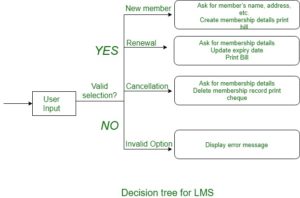A Decision Tree offers a graphic read of the processing logic concerned in a higher cognitive process and therefore the corresponding actions are taken. The perimeters of a choice tree represent conditions and therefore the leaf nodes represent the actions to be performed looking on the result of testing the condition.
For example, consider Library Membership Automation Software (LMS) where it ought to support the following three options: New member, Renewal, and Cancel membership. These are explained as following below.
1. New Member Option:
- Decision:
Once the ‘new member’ possibility is chosen, the software system asks details concerning the member just like the member’s name, address, number, etc. - Action:
If correct info is entered then a membership record for the member is made and a bill is written for the annual membership charge and the protection deposit collectible.
Renewal Option:
- Decision:
If the ‘renewal’ possibility is chosen, the LMS asks for the member’s name and his membership range to test whether or not he’s a sound member or not. - Action:
If the membership is valid then membership ending date is updated and therefore the annual membership bill is written, otherwise, a slip-up message is displayed.
Cancel Membership Option:
- Decision:
If the ‘cancel membership’ possibility is chosen, then the software system asks for member’s name and his membership range. - Action:
The membership is off, a cheque for the balance quantity because of the member is written and at last the membership record is deleted from the information.
Decision tree representation of the above example:
The following tree shows the graphical illustration of the above example, when obtaining data from the user, the system makes a choice and then performs the corresponding actions.

